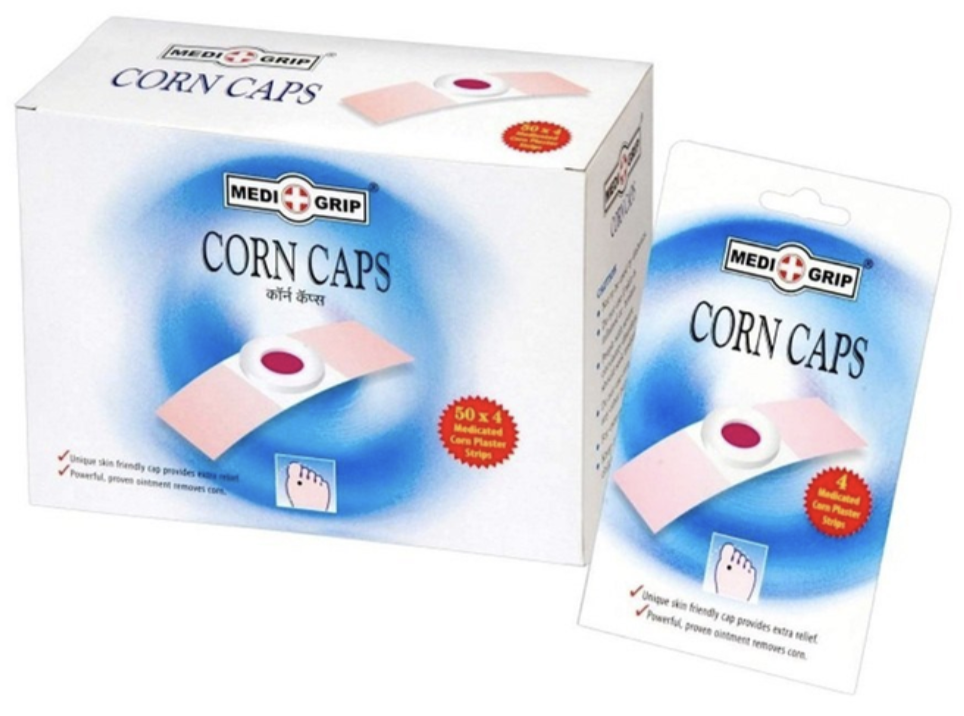Corn Caps: Guide, Uses & Safety


What is a Corn Cap?
Corns, often called helomas, are patches of thickened skin that commonly appear on the feet due to friction or pressure. They usually form as a small, cone-shaped buildup of hard skin, which is the body’s way of protecting itself. Factors like foot shape, bony bumps, poorly fitting shoes, or walking patterns can make them worse and often painful. Corn caps, also known as corn plasters, offer a safe and effective way to ease discomfort and remove these growths.
Corn Cap Uses and Benefits of Corn Cap
Corn caps uses are often targeted relief for the pain and discomfort caused by corns by easing pressure on the affected area. The active ingredients help soften the hardened skin, making corns easier to remove and supporting natural healing. They also act as a protective cushion, reducing friction and irritation from footwear while walking. As a convenient at-home remedy, corn caps provide an effective alternative to clinical treatments. With regular use, they promote overall foot health by preventing corns from worsening. Additionally, they are versatile and suitable for treating different types of corns, with each pack allowing multiple applications for various affected areas.
How Does a Corn Cap Work?
Corn caps usually contain salicylic acid in strengths of 10%, 20%, or 40%, depending on the severity of the corn. The medicated pad softens the hard skin by breaking down keratin, making it easier to remove the corn while cushioning the area to reduce pain from friction. While effective, users should be cautious not to apply corn caps on broken or infected skin, and people with diabetes or poor circulation should only use them under medical guidance to avoid complications.
Corn Cap Side Effects: Risks and Precautions for Bulk Buyers
Corn caps work well for softening and removing corns, but they do come with a few risks. Since they contain salicylic acid, there’s a chance the surrounding healthy skin may get damaged, especially if the cap isn’t used carefully. People with sensitive skin or conditions like diabetes need to be extra cautious, as misuse can cause wounds. Another drawback is that corn caps only provide temporary relief and don’t address the real cause, such as constant pressure or friction from footwear. In some cases, trying to treat corns on your own can also increase the risk of infection, particularly if the skin is cut or irritated.
Steps for Effective Corn Cap Treatment
- Wash your feet with mild soap and water, then pat dry to ensure the cap sticks properly.
- Place the medicated side directly over the corn and press gently so it stays in place.
- Keep the cap on for the recommended time (usually 24–48 hours) so the medication can soften the corn.
- After removing the old one, clean the area again and apply a new cap if needed.
- Let the corn soften naturally; forcing it off may injure the skin.
- Choose well-fitted shoes to reduce pressure and prevent corns from coming back.
Applying Corn Cap Bandages in a Clinical Setting
In a clinical setting, applying corn cap bandages is done with care to ensure both comfort and effectiveness. The area around the corn is first cleaned and dried thoroughly to improve adhesion. The medicated side of the bandage is then placed directly over the corn, targeting the hardened skin while cushioning it from further friction. Patients are advised to keep the bandage on for the recommended duration and return for follow-up if the corn persists or if there are signs of irritation. This simple yet effective approach helps manage discomfort while supporting overall foot health. For understanding how to remove corn after using corn cap refer to the packaging instructions.
Industry Trends in Corn Cap Solutions
Corn cap solutions have evolved over the years, moving beyond simple medicated plasters to more advanced and user-friendly options. Modern corn caps now use improved adhesive materials that stay in place longer and provide better cushioning, making them more comfortable for daily wear. Many brands also focus on adding skin-friendly formulations to reduce irritation and improve healing. With increasing awareness around foot health, there is also a growing trend toward corn care products that combine corn cap treatment with prevention, offering solutions that not only remove corns but also protect feet from developing new ones.
FAQs








